Microsoft Teams is a collaborative workspace within Microsoft 365 that serves as a central hub for workplace conversations, teamwork, video chats, and document sharing. Due to the coronavirus pandemic and the resultant widespread adoption of a work from home model, there has been a dramatic increase in the number of Teams users, rising to 145 million users in April 2021, making Teams the fastest growing business app in Microsoft’s history. Widespread adoption of Teams by businesses also means there is an increase in risk of data loss due to a wide variety of reasons. Given the fact that Microsoft is not responsible for backing up your data, retaining Teams data is the responsibility of IT administrators so that business data is available at all times. This will come handy in the event of data loss and will also ensure legal compliance.
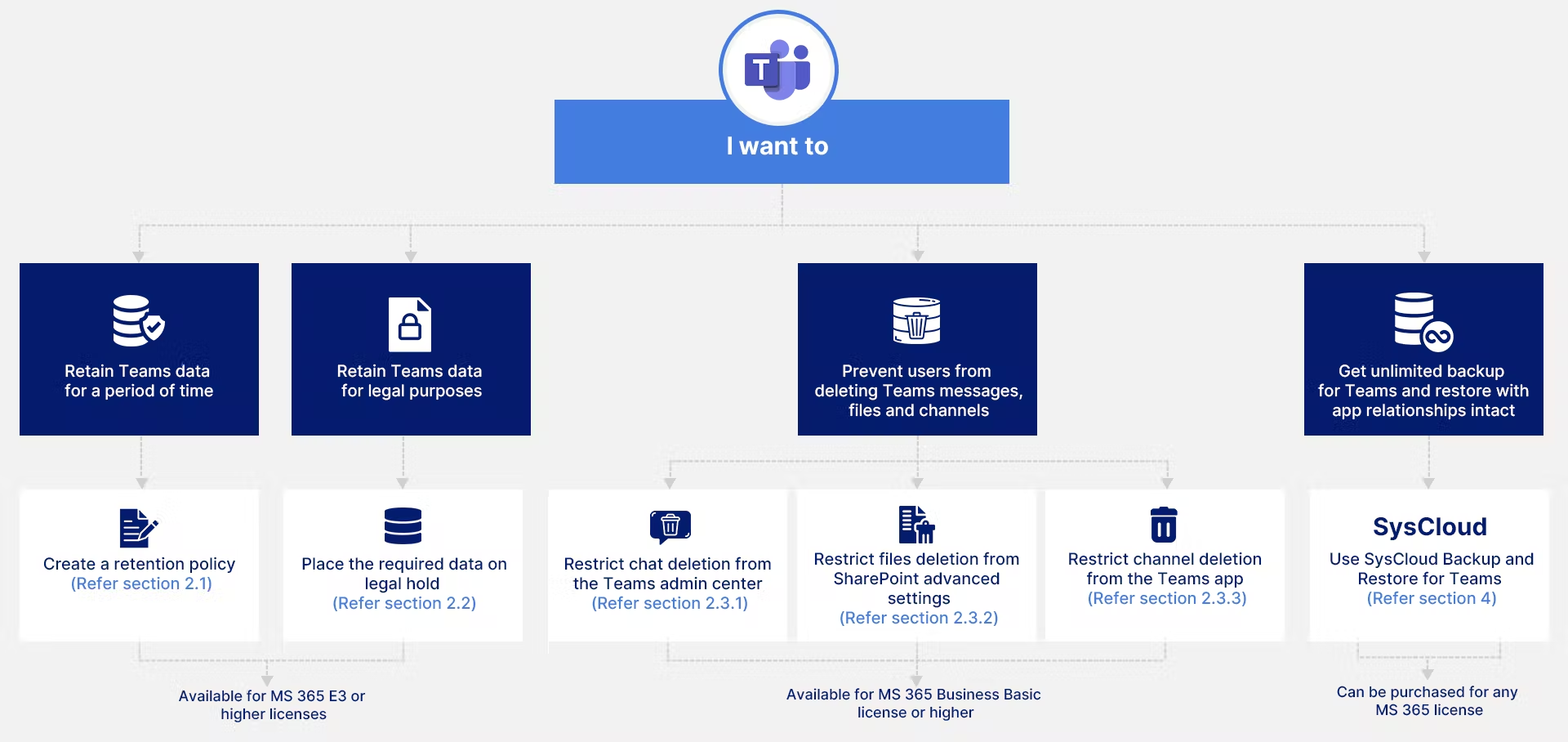
To understand how retention works with Microsoft Teams, it is important to know where Microsoft Teams data is stored. Since Teams is a productivity hub that utilizes many applications and services across Microsoft 365, it stores data across multiple locations. To learn where the different types of data created or shared via Teams get stored, read our article A Guide to Teams Data Storage Location.
1. Default Microsoft 365 retention
1.1. Default Exchange retention
Items deleted from Exchange Online are moved to the Deleted Items folder where they remain for thirty days or until a user/admin empties it. When data is deleted from the Deleted Items folder, it is moved to the Recoverable Items folder where it is kept for 14 days (the period can be extended to 30 days via power shell) during which a user or an admin can restore it.
1.2. Default SharePoint retention
The data retained by default Microsoft retention is counted towards your Microsoft 365 storage quota, and you will need to purchase additional storage if you exceed the limit. Try SysCloud backup for Microsoft 365 to save on additional storage costs.
1.3. Limitations of default Microsoft 365 retention
- The data retained using the default retention is counted towards your Microsoft 365 storage quota, and you will need to purchase additional storage if you exceed the limit.
- Chat/channel messages aren't protected by standard Microsoft retention.
- Data is permanently deleted once the default retention period expires.
2. How can you retain Microsoft Teams data?
2.1. Retain Teams data using retention policy
2.1.1. Introduction to Teams retention policy
2.1.2 Licensing requirements:
- Microsoft 365 E5/G5/A5/E3/G3/A3
- Office 365 E5/G5/A5/E3/G3/A3/F3/E1/G1
Learn more about Microsoft 365 licensing requirements.
2.1.3. Retention policy for Teams chat and channel messages
How to create a retention policy for Teams chat and channel messages
Note: To create and configure retention policies, one needs to be a global admin or a compliance admin.
Step 1: Open the Compliance admin center and navigate to the Information governance section.
Step 2: Select Retention policy -> New retention policy. Name your retention policy
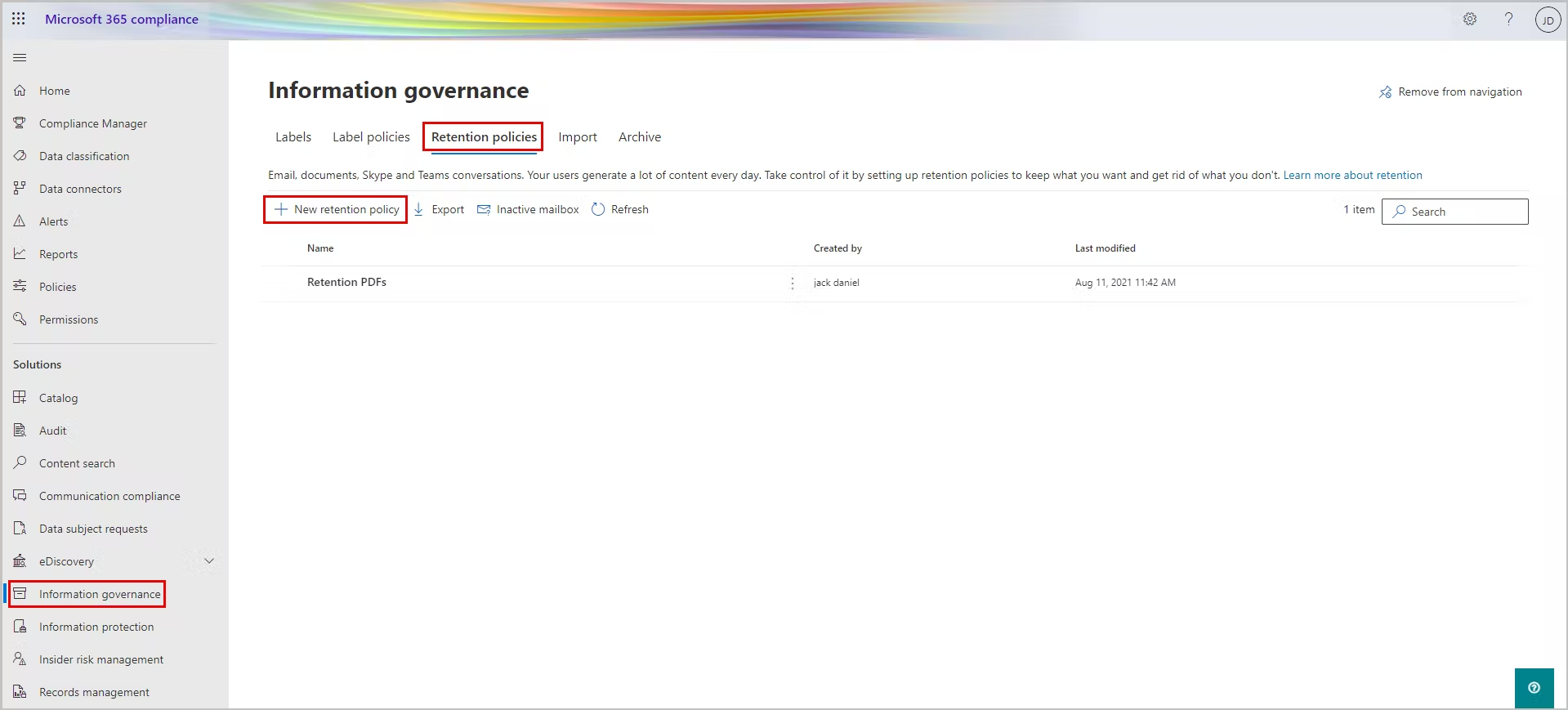
Step 3: In the Locations page, select any or all of the locations for Teams:
-Teams channel message: Messages from standard channel chats and standard channel meetings, but not from private channels that have their own policy location
-Teams chats: Messages from private 1:1 chats, group chats, and meeting chats
-Teams private channel messages: Messages from private channel chats and private channel meetings
Note: Teams private channel messages” location has to be selected separately and cannot be selected at the same time as the other two locations.
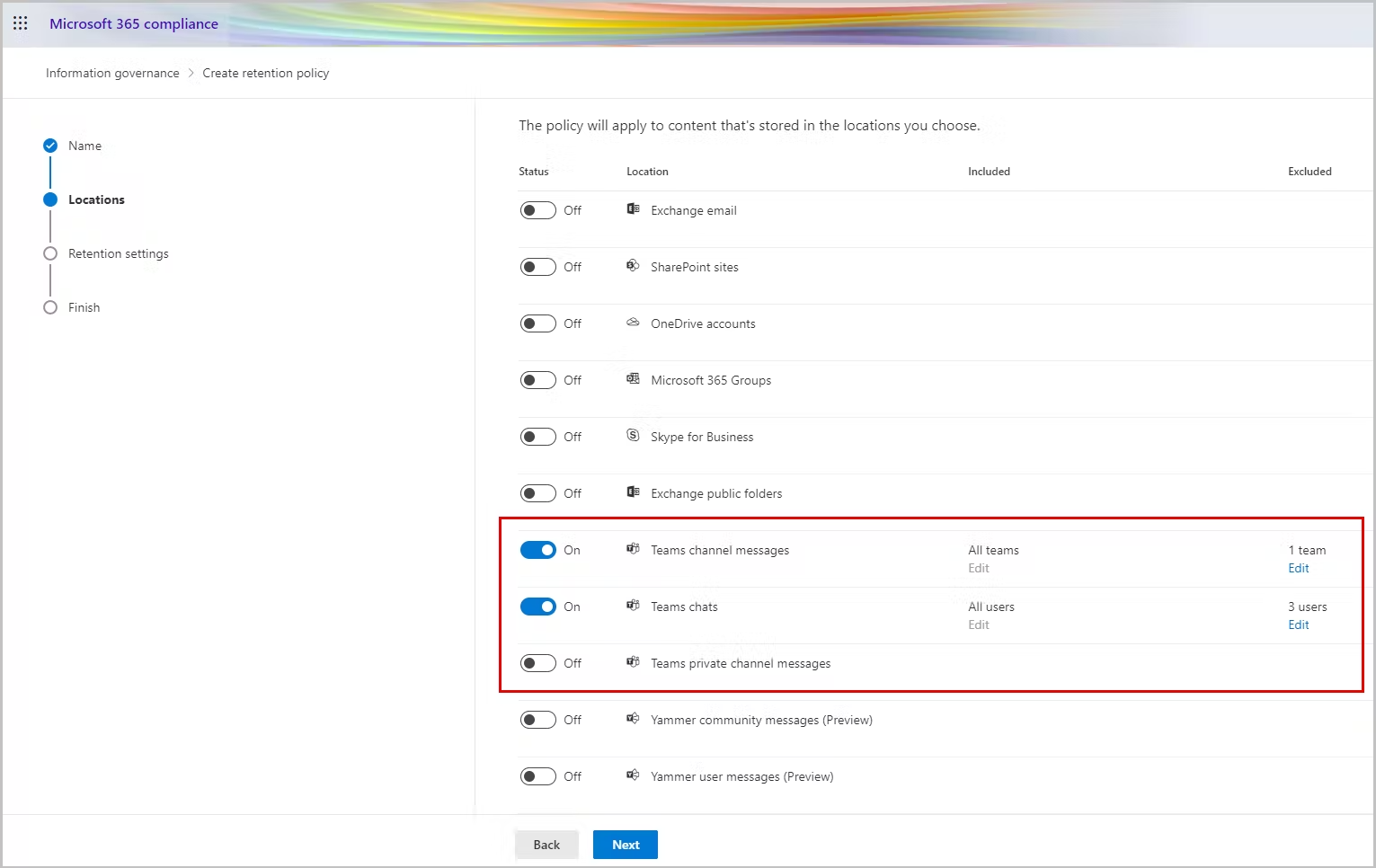
Step 4: Configure the retention settings and click on the Next button.

Step 5: Review the settings and click Submit. Your new retention policy will be created.
How retention works with Teams chat and channel messages
If you configure a Teams retention policy to retain chats or channel messages, users can still edit/delete messages within the Teams app. They can no longer see their pre-edited or deleted messages within the Teams app but a copy of these messages is retained in a secure location that's designed for eDiscovery searches by compliance administrators. (Learn more about the different locations in which Teams data get stored) Permanent deletion of chat/channel data doesn’t happen before the end of the configured retention period.
For private chats or group chats : Messages older than the retention policy configuration are deleted and an automatically generated message stating "We've deleted older messages due to your org's retention policy" is shown on top of yet undeleted messages.
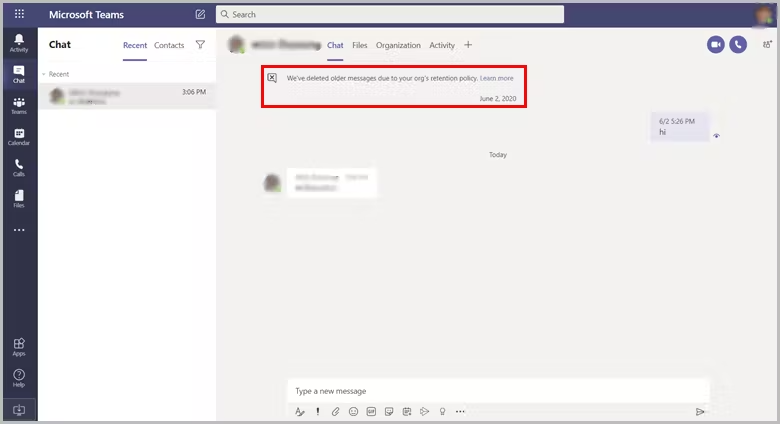
For channel messages: Messages older than the retention policy configuration are deleted. If the deleted message was a parent message of a threaded conversation, a message stating “This message has been deleted because of a Retention Policy” will be displayed in place of the parent message. All replies in the thread which are still within the retention period will remain.
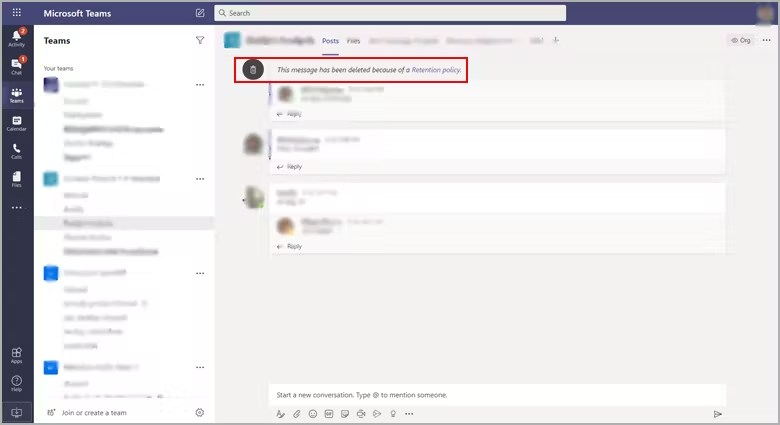
If the messages which were previously subjected to a retention policy (for deletion) are now deleted/edited by users within the app, these messages will be deleted from the secured location and no longer accessible via eDiscovery searches. For more information on how retention works for Teams chat and channel messages, click here.
2.1.4. Retention policy for files shared in Teams
Retained files are stored in the Preservation Hold Library, and data in the Preservation Hold Library counts against your SharePoint storage quota. The total SharePoint storage limit per organization is set at 1TB plus 10GB x number of licensed Microsoft 365 users in your tenant. If you exceed the limit, you will have to purchase additional storage priced at $200/month/TB. To save on storage costs, you can opt for a third-party backup solution, like SysCloud.
How to create a retention policy for Teams files
Step 1: Open the Compliance admin center and navigate to the Information governance section.
Step 2: Select Retention policy -> New retention policy. Name your retention policy.
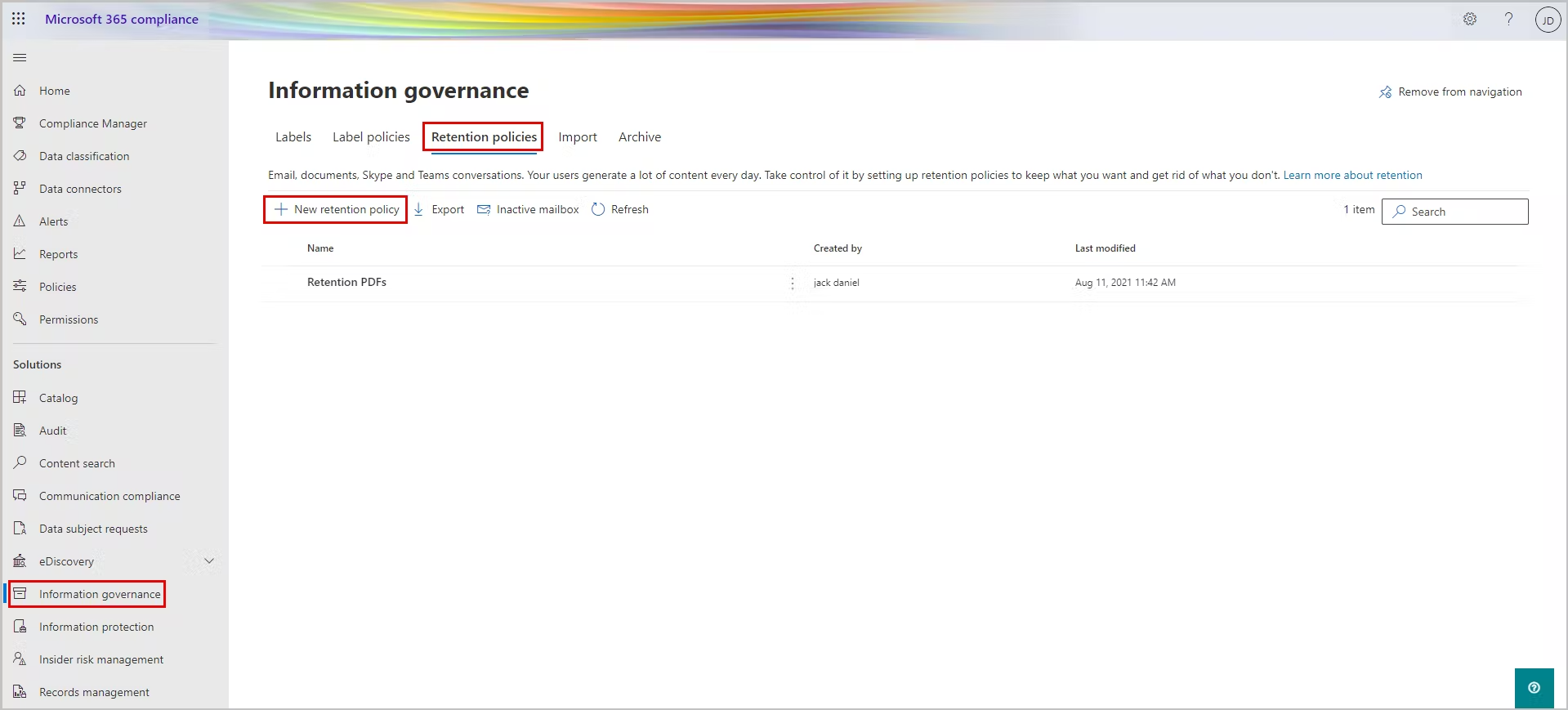
Step 3: In the Locations page, select the SharePoint site or OneDrive accounts corresponding to the channel or chat files you want to retain.

Step 4: Configure the retention settings and click on the Next button.

Step 5: Review the settings and click Submit. Your new retention policy will be created.
Note: If you have a retention policy that deletes a file shared in a Team chat or channel message before the message itself is deleted, then the file will still continue to show up in the Teams message. However, if you click on the file you’ll receive a “File not found” error. You could also receive this error if someone were to manually delete the file from SharePoint Online or OneDrive for Business with no retention policy in place.
To learn more on how retention policy works for SharePoint, read this article.
2.1.5. Retention policy for Teams data stored in Exchange Online
Click here to know more about retention for Exchange Online data.
2.1.6. Retention policy for Teams created from Microsoft Groups
How to create a Groups retention policy
Step 1: Open the Compliance admin center and navigate to the Information governance section.
Step 2: Select Retention policy ->New retention policy. Name your retention policy.
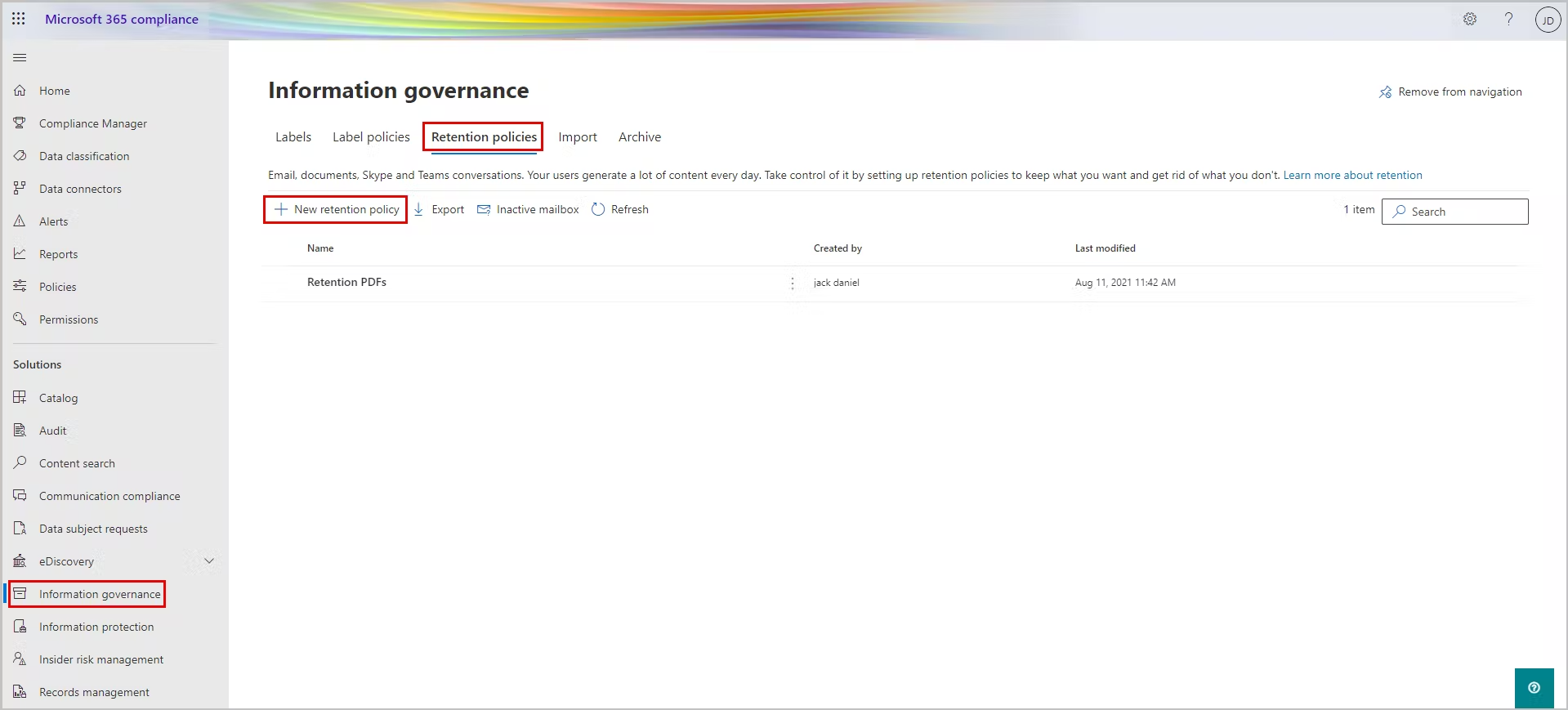
Step 3: In the Locations page, select the group from which the team was created.

Step 4: Configure the retention settings and click on the Next button.

Step 5: Review the settings and click Submit. Your new retention policy will be created.
To change the default because you want the retention policy to apply to either just the Microsoft 365 mailboxes, or just the connected SharePoint teams sites, use the Set-RetentionCompliancePolicy PowerShell cmdlet with the Applications parameter having one of the following values:
Group : Exchange for just Microsoft 365 mailboxes that are connected to the group.
Group : SharePoint for just SharePoint sites that are connected to the group.
Group : Exchange, SharePoint. (Reference :Microsoft documentation)
2.2. Retain Teams data using legal holds
To learn more about legal holds and how to place Teams data on hold, read this article.
2.3. Restricting accidental deletion by users
2.3.1. How to restrict chat deletion from the Microsoft Teams Admin Center
Step 1: Go to the Teams admin center. Navigate to Messaging policies and click on the +Add button.

Step 2: Disable the policies Owners can delete sent messages and Delete sent messages. You can also disable Edit sent messages policy if you don’t want users to edit sent messages. Click Save.

2.3.2. How to restrict files deletion using SharePoint advanced settings
Step 1: Open the SharePoint document library for which you want to edit user permissions.
Step 2: Click the gear icon and select Library settings.

Step 3: Under Permissions and Management, select Permissions for this document library.
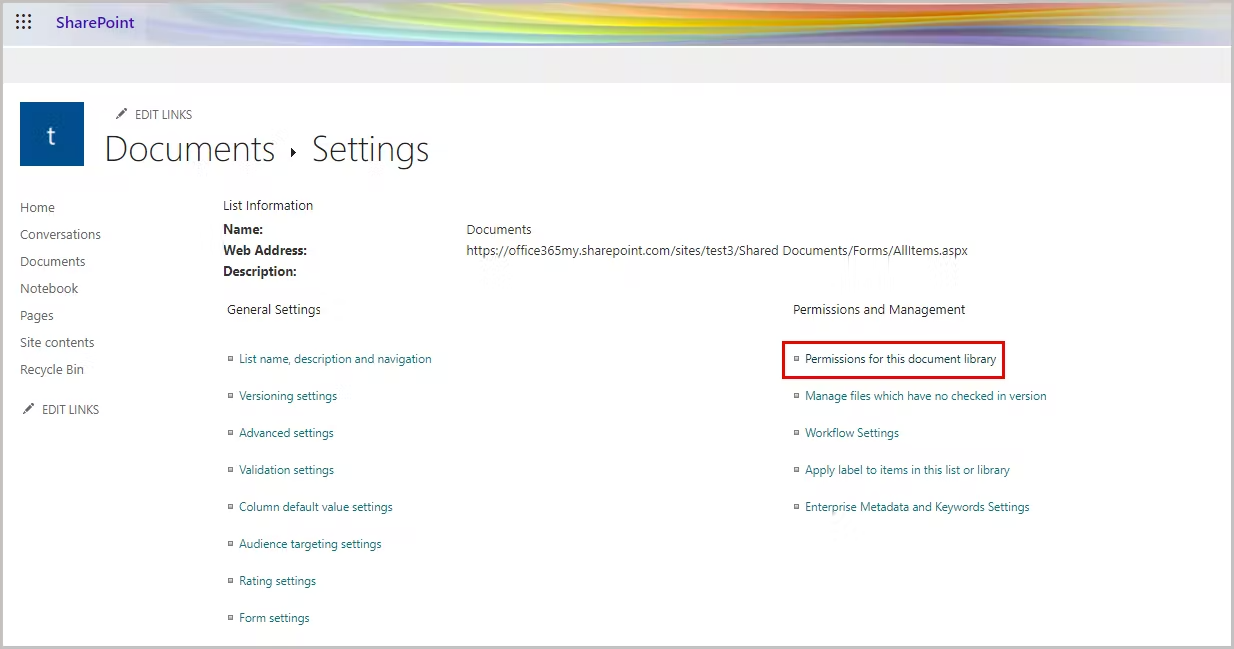
Step 4: Select Stop Inheriting Permissions to prevent users from inheriting the permissions of the parent site.
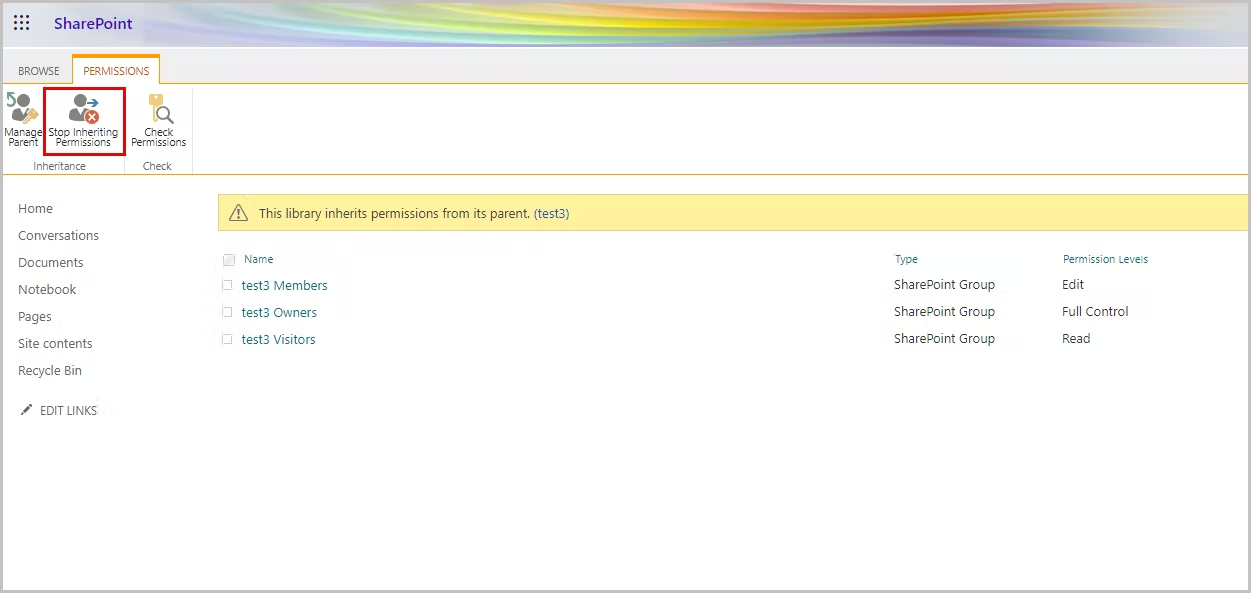
Step 5: Go to Edit User Permissions. To prevent users from deleting Teams files, change the permission to Read.
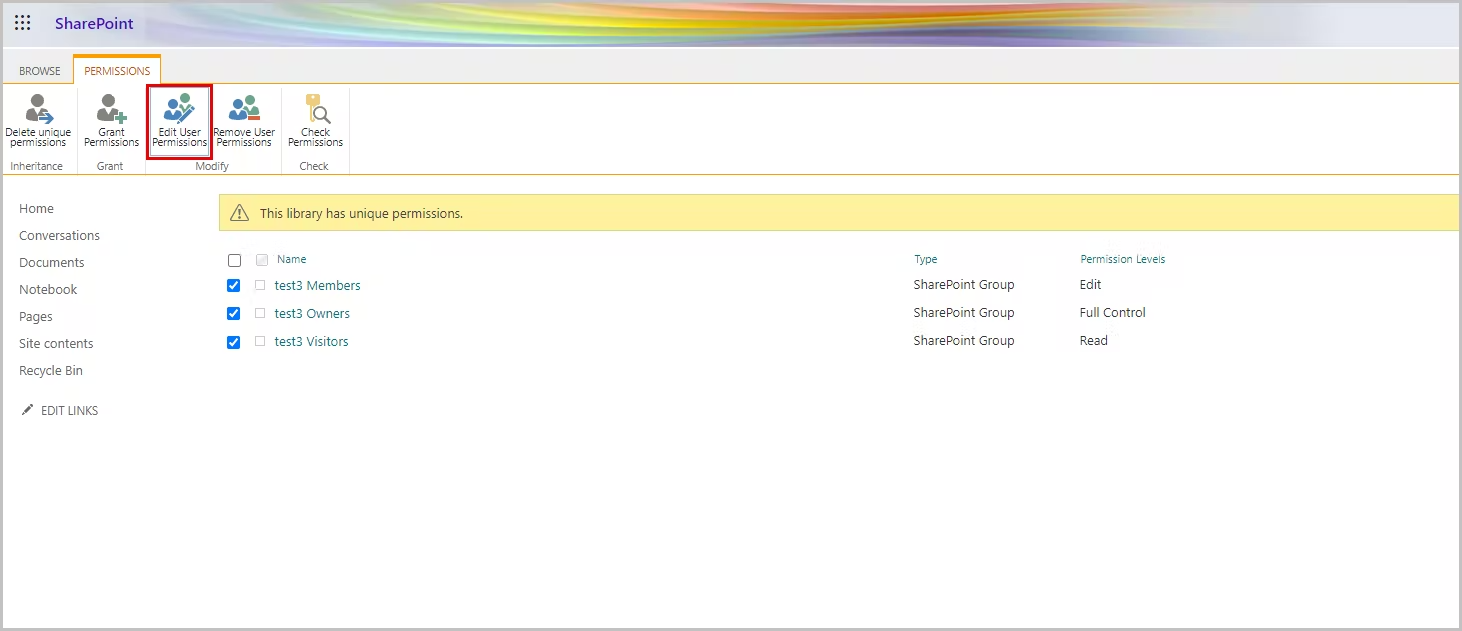
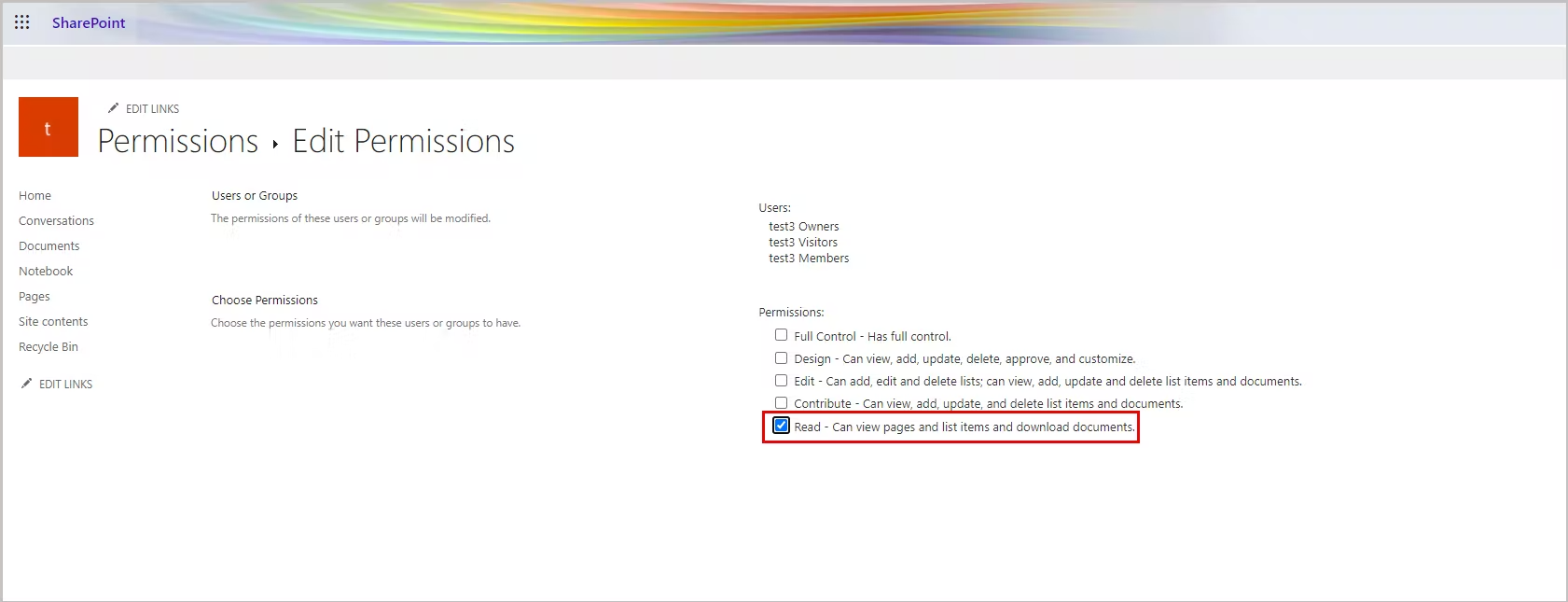
You can also edit the user permissions for the whole site instead of a document library. To do this, open the team site -> click the gear icon -> Site permissions -> Advanced permission settings, and follow the rest of the steps as mentioned above.

You can also edit the user permissions for specific files. To do this, right click the required file -> Manage access -> Advanced, and follow the rest of the steps as mentioned above.
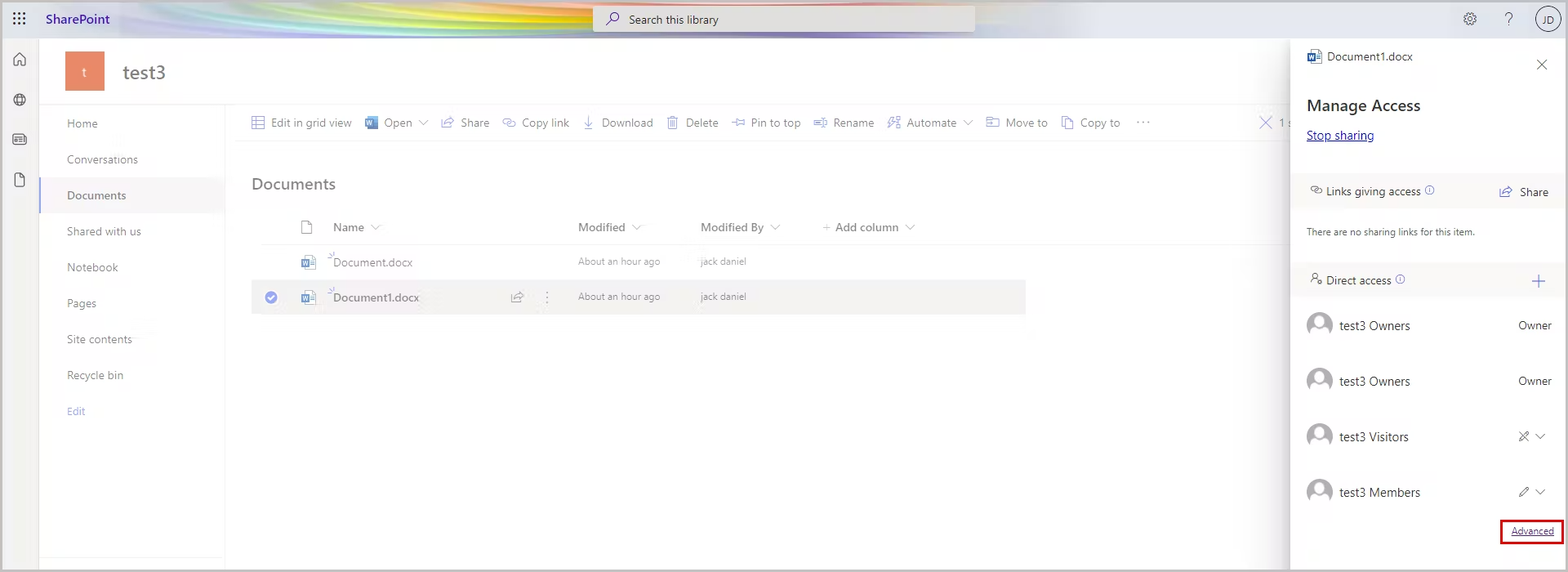
2.3.3. How to restrict channel deletion from the Teams application
Note: You need to be a team owner to perform this.
Step 1: In the Teams application, click the three dotted lines next to the team name, then choose Manage team from the drop-down menu.
Step 2: Navigate to Settings. Under Member permissions, uncheck the option Allow members to delete and restore channels.

2.4 Limitations of native Teams data retention options
- Retained data counts towards your Microsoft 365 storage quota. Each user has a limited storage available. If you delete data to stay within the storage limit, the deleted data cannot be recovered. Because Microsoft keeps the full versions of all deleted and modified data (no incremental backup is provided), Microsoft 365 storage limits can be reached fast.
- Unlike third-party backup tools, native retention methods lack automated recovery features. In the event of a data loss, retained data can only be exported offline and need to be restored manually. Restoring a large amount of data will require a lot of manual effort and time.
- Data belonging to deleted user accounts are not retained, so if you need to retain data of employees who left the company, you must continue paying Microsoft for the user licenses.
- Retention policies and legal holds are part of the Compliance Center which is only available in senior E3/E5 plans that are more expensive than Microsoft (Office) 365 Business plans.
2.5 Retain Teams data using third - party backup solutions
2.5.1. Why should you use third-party cloud backup tools to back up Microsoft Teams?
The following are the advantages of using third-party cloud backup tools like SysCloud to backup your Teams data:
Save Licensing Costs: Keep a safe copy of Teams data even after the user accounts are deleted. This happens mostly during employee exits, thus saving on license costs.
Access Data During Outages: Access your Teams data via SysCloud backup app even when Microsoft 365 suffers an outage, which is not very uncommon.
Added-Security: Gain added data security with increased admin control and in-built protection for ransomware attacks.
Automatic/ Scheduled Backup: Schedule automated backups multiple times during the day.
Regular activity reports: Get granular reports of all the activities in the backup account.
3. What happens when Teams data is deleted
3.1 If an entire team is deleted:

3.2. If a Teams channel is deleted:

3.3 If Teams SharePoint files are deleted:
Without retention: On deletion, Teams data stored in SharePoint moves to the first-stage Recycle Bin where it remains for 93 days unless someone deletes it from there. In that case, the data moves to the second-stage Recycle Bin where it stays for the remainder of the 93 days, before getting permanently deleted. The administrator can contact Microsoft support within 14 days of deletion (from the second-stage Recycle Bin) for a site-level recovery, but restore is not always guaranteed.
With retention: If a retention policy is in place, a copy of the original data will be created in the Preservation Hold Library, where it stays until the end of the retention period. Once the retention period expires, the data moves to the second-stage Recycle Bin, and is permanently deleted at the end of 93 days. Learn more.

3.4 If Teams channel messages are deleted:
Without retention: When you delete channel messages, they are permanently deleted and cannot be recovered by anyone unless retention has been enabled for Teams channel messages.
With retention: Channel messages are stored in a hidden folder in Exchange Online for compliance purposes. Deleted messages go to another hidden folder in Exchange, called the SubstrateHolds folder (part of the Recoverable Items folder), where they remain until the retention period expires. Once the retention period expires, these messages are permanently deleted.
To know how to recover deleted Teams data, read our article How to Recover Deleted Teams Data.

4. SysCloud backup for Microsoft Teams
Using SysCloud, administrators can back up Teams channels as well as SharePoint sites associated with different teams. Both public and private teams can be backed up. Admins have the option to either back up specific teams whenever required or enable Auto Backup feature to automatically back up Teams data.
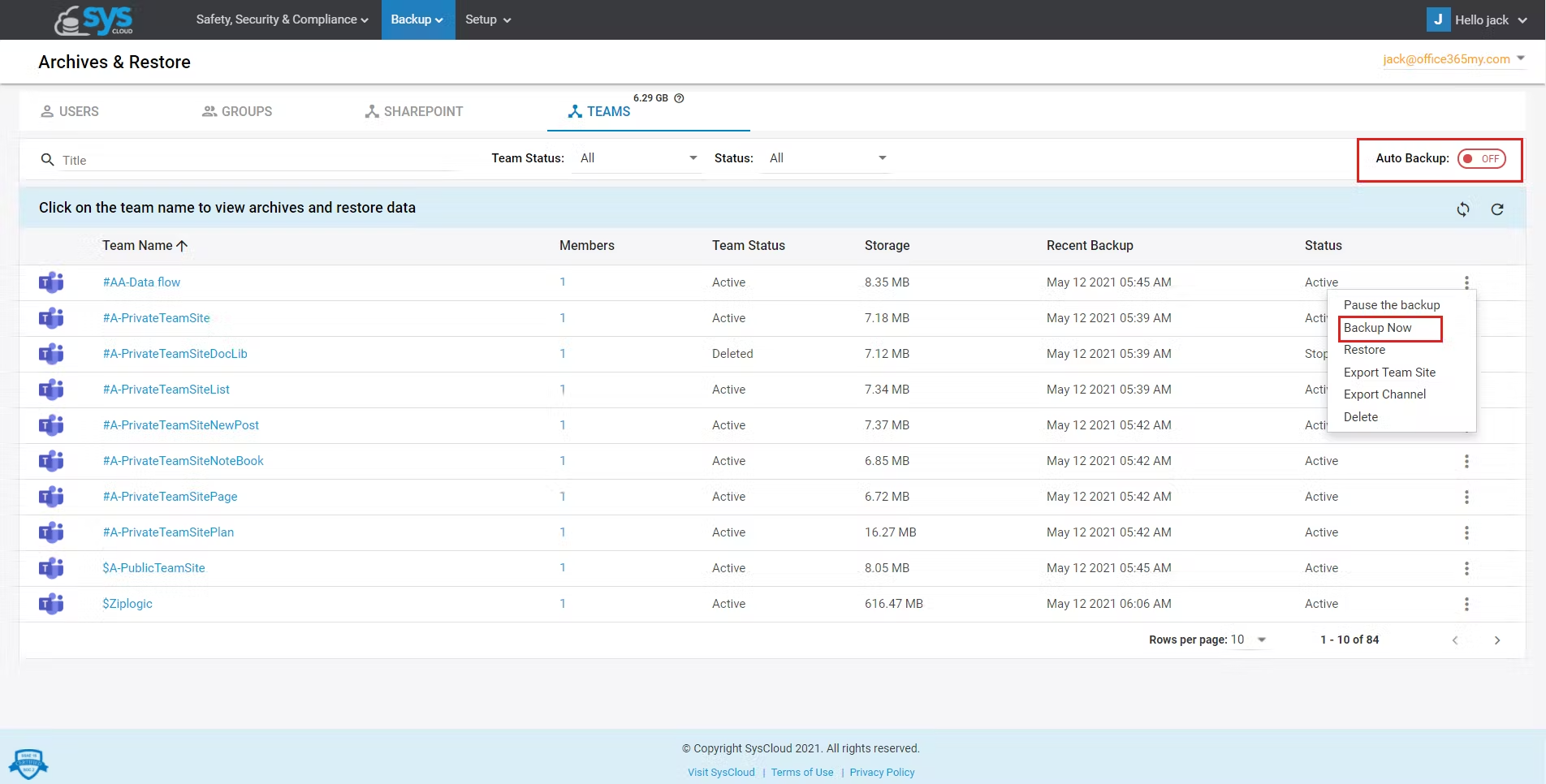
4.1 Channel backup
SysCloud backs up every conversation thread within a Teams channel as a separate entry. This includes all the URLs and media files shared throughout the conversation. Admins can export an entire channel or specific conversation threads from the backup archives whenever needed. The exported data is available for download in the Reports page under SHAREPOINT AND TEAMS EXPORT.

4.2 Site content backup

